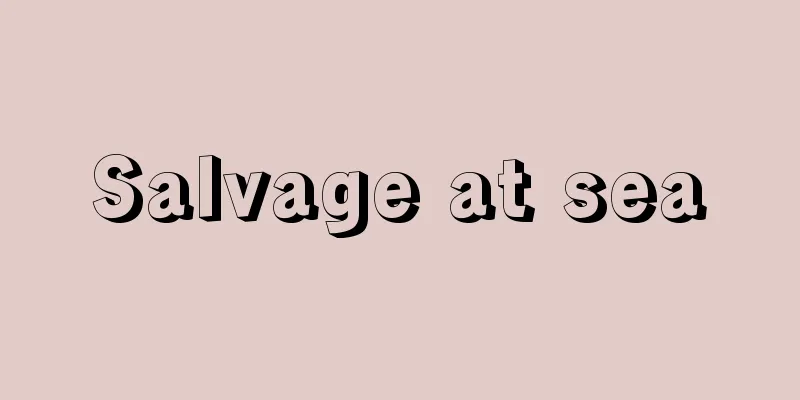Salvage at sea

|
When a ship encounters a disaster at sea, it can cause considerable loss of life and property. In particular, the increasing size of ships, the diversification of cargoes, and the congestion of ship traffic are increasing the risk and severity of disasters at sea. [Shintani Fumio] International Convention for Salvage at SeaRescue of a ship in distress involves search (reporting, detection, dispatch) and rescue operations, and to carry out these tasks effectively across the vast ocean, not only is it necessary to have the necessary facilities and technology, but international cooperation is also essential, and various treaties have been concluded to carry this out. Article 12 of the 1968 Convention on the High Seas (Convention No. 10 of 1968) states: [1] Requires the master of a ship flying the flag of any State to take the following measures, insofar as such measures do not involve serious danger to the ship, its crew or passengers: (1) To render assistance to any person found in danger of losing his life at sea. (2) Upon receiving a notice of a vessel requiring assistance, proceed to the rescue of any person in distress at the fastest speed which the master of the vessel can reasonably be expected to accomplish. (3) In the event of a collision, render assistance to the other vessel and its crew and passengers and, if possible, inform the other vessel of the name, port of registry, and nearest port of call of the casualty vessel. [2] Every coastal State shall promote the establishment and maintenance of adequate and effective search and rescue services for safety at sea and, where circumstances so require, shall cooperate with adjacent States for this purpose through mutual regional arrangements. Regulation 10 (Distress Notification) of Chapter 5 (Safety of Navigation) of the 1974 International Convention for the Safety of Life at Sea states, "When the master of a ship at sea receives a signal from whatever source indicating that a ship or raft is in distress, he shall proceed with full speed to the rescue of those in distress and, if possible, shall notify those in distress to that effect. If it is impossible to proceed to the rescue, or if owing to special circumstances it is unreasonable or unnecessary, the master shall record in the ship's log the reasons for not proceeding to the rescue of those in distress." Regulation 15 (Search and Rescue) states as follows: (1) The Contracting Governments undertake to ensure that the necessary measures are taken for the surveillance of the coasts and for the rescue of persons in distress in coastal waters. These measures shall include the establishment, operation and maintenance of such maritime safety facilities as may be deemed practicable and necessary, having regard to the density of maritime traffic and the dangers to navigation, and shall, so far as possible, provide adequate means for locating and rescuing persons in distress. (2) The Contracting Governments undertake to make available information on existing rescue facilities and on plans for changes thereto. Lifesaving signals are used by rescue facilities, maritime rescue teams and aircraft engaged in rescue operations to communicate with and guide ships in distress. These signals are specified in the International Maritime Organization (IMO) guidelines and the International Code of Signals. The 1979 International Convention on Search and Rescue at Sea (SAR Convention) Furthermore, in 1990, the International Convention on Oil Pollution Preparedness, Response and Cooperation (OPRC Convention) was concluded. In response to this, Japan amended the Marine Pollution Prevention Law in part and, through a review of oil spill prevention plans, etc., more than 110 disaster prevention organizations, such as the Oil Spill Prevention Council, have been established throughout the country as joint public-private investigation and prevention organizations to enable swift prevention measures. [Shintani Fumio] National legislation regarding salvageIn Japan, the Seamen's Act (Act No. 100 of 1947) commands the captain to (1) take all necessary measures to save human lives and the ship and its cargo when his ship is in imminent danger, and (2) take all necessary measures when he learns of another ship or aircraft in distress, except in cases where the captain has confirmed with the distressed ship that there is no need for assistance based on the circumstances of his ship and that the other ship is not rushing to the rescue. The Port Regulations Law (Law No. 115 of 1948) and the Maritime Traffic Safety Law (Law No. 95 of 1972) stipulate that a ship in distress must move, set up markers, and take other measures to prevent danger to ship traffic, and must report the details of the accident and the measures taken to a coast guard agency. As for rescue measures in particular, the Water Rescue Law (Law No. 95 of 1899) stipulates that (1) when a ship in distress becomes known, the mayor of the city, town or village shall rush to the scene and take the necessary measures for rescue, and (2) police officials shall assist the mayor of the city, town or village in carrying out rescue work, and when the mayor is absent from the scene, they shall perform the duties of the police in his place. [Shintani Fumio] Rescue services at sea in JapanThe Japan Coast Guard's responsibilities include "rescuing lives, cargo, and ships in the event of accidents at sea, as well as providing assistance in the event of natural disasters or other situations requiring relief." In order to provide swift and effective rescue services for victims in distress at sea, the Japan Coast Guard engages in rescue operations for victims in distress at sea under a global cooperative framework based on the 1979 SAR Convention. [Shintani Fumio] National rescue systemThe Global Maritime Distress and Safety System (GMDSS) system was introduced in 1992 as a maritime distress and safety communications system, which enables a ship in distress anywhere in the world to quickly and reliably request rescue from search and rescue agencies and nearby ships. With the full implementation of GMDSS on February 1, 1999, the JCG is now equipped to check the location of a ship in distress when it receives a distress alert, search for the ID (the identification signal included in the distress signal) to collect detailed information such as the name, owner, and contact information of the ship in distress, and to dispatch patrol vessels or aircraft to carry out search and rescue operations. The JCG also endeavors to carry out prompt and accurate rescue operations at sea by confirming the safety of the ship in distress by radio telephone, and by requesting rescue from nearby ships. If necessary, the JCG requests assistance in search and rescue from the Self-Defense Forces' vessels and aircraft, as well as the U.S. military, and in the event of a marine accident occurring abroad, the JCG requests assistance from the relevant country through the Ministry of Foreign Affairs. Furthermore, in order to carry out prompt and accurate rescue operations at sea, the JCG is equipped to listen to distress frequencies corresponding to GMDSS 24 hours a day at 22 land communication stations nationwide and patrol vessels in operation, and is ready to respond immediately to distress alerts. As part of our satellite-based information gathering system, we operate a 24-hour system consisting of ground receiving stations that receive distress alerts from EPIRBs (polar-orbiting satellite-based emergency position-indicating radio beacons) installed on ships and aircraft, relaying them via Cospas and Sarsat satellites, and a Operations Control Center (MCC) that distributes distress alerts from the ground receiving stations to the appropriate rescue coordination headquarters. As of the end of fiscal year 1999, the Japan Coast Guard had 519 vessels (153,578 gross tons), of which 123 security and rescue vessels were patrol vessels (52 large patrol vessels, including 3 patrol vessels with two helicopters, 9 patrol vessels with one helicopter, and 35 1,000-ton patrol vessels), 234 patrol boats, and 83 special rescue boats, totaling 440. In addition, the Japan Coast Guard had a total of 73 aircraft, including 29 planes and 44 helicopters, which were assigned to 14 air bases and 9 coast guard offices nationwide. [Shintani Fumio] Private support organizationsThe waters off the coast of Japan are a place where ships, pleasure boats, fishing boats, and construction work are very common, and so there are many accidents at sea, and because patrol boats and aircraft cannot be adequately deployed along the extremely long coastline (approximately 32,170 km), emergency rescue is necessary for nearby ships and coastal residents. For this reason, there is the Japan Marine Rescue Association, a private volunteer organization that has set up 599 rescue stations and 412 rescue branches along the coast (as of October 2000), staffs rescuers, owns small rescue boats, and works together with fishery cooperatives and marinas to form "Regional Maritime Rescue Liaison Councils." Furthermore, with the cooperation of the Japan Coast Guard and other government agencies and related organizations, an "Offshore Emergency Center" (1 location) and "Offshore Emergency Center Regional Branches" (10 locations) have been established throughout the country as the operating bodies for the offshore rescue system. To support this operation, the "Offshore Emergency Support Councils" (13 locations) are also made up of maritime and medical personnel, and an offshore emergency system has been established that brings together the public and private sectors. In addition, the Boat Sailing Safety Council, the Scuba Diving Safety Council, and the Marine Leisure Safety and Promotion Association also cooperate in maritime rescue. [Shintani Fumio] Number of ships needing rescueIn fiscal 1999, the number of vessels requiring rescue was 1,920 (635,084 tons), of which 694 were fishing boats (36.1%), 806 were pleasure boats (42.0%), 169 were cargo ships (8.8%), 35 were tankers (1.8%), 32 were passenger ships (1.7%), and 184 were other vessels (9.6%). In addition, 7,840 people were lost at sea, of which 157 were killed or went missing. Of these marine accidents, 91.4% occurred within 12 nautical miles of the shore (in waters less than 12 nautical miles from the coast). [Shintani Fumio] Responding to ships in distressMasters and officers of ships are internationally required to have knowledge of the following items as minimum emergency measures: (1) precautions to take when grounding a ship, (2) measures to be taken before and after grounding, (3) refloating a grounded ship with assistance or by itself, (4) measures to be taken in case of collision, (5) temporary sealing of flooded areas, (6) measures to be taken for the protection and safety of passengers and crew in case of emergency, (7) minimizing damage to the ship and salvaging the ship in case of fire or explosion, (8) abandoning ship, (9) emergency ship handling, installation and use of temporary rudder equipment, and installation of temporary rudder when possible, (10) rescue of human lives from a ship in distress or wreck, (11) rescue of persons who have fallen overboard, etc. "Grounding" is a concept that includes a state in which a ship's bottom touches the land or the seabed and cannot move, as well as being stranded and stranded. When a marine accident occurs, the captain must report the following to the shipowner and also to the coast guard (the shipowner may act on his behalf): (1) the date, time, location, cause and progress of the accident, and the weather and sea conditions at the scene; (2) the safety of the crew and the status of the damage; (3) the first aid being taken and whether a rescue ship is needed; (4) in the case of a collision, the name, damage and movements of the other ship; (5) in the case of a grounding or stranding, the speed, current, tide height and position, and the condition of the nearby bottom and seabed; (6) the load and current amount in ballast tanks (tanks that store fresh water or seawater as bottom load) and fuel tanks, etc. before the accident; (7) whether the main engine and auxiliary engines can be used; and (8) in the case of a fire, the location of the fire, the status of the cargo, the fire-extinguishing measures, and the prospects for extinguishing the fire. Usually, the shipowner, in consultation with the Japan Coast Guard, insurance companies, cargo owners, etc., will decide on rescue measures based on the report from the distressed ship, such as dispatching a rescue ship and a place for repairs after the rescue, and will select a salvage company. If a salvage is contracted, it is not a salvage under the Maritime Act, but is a contract for service. Once a salvage company has been selected, the captain will consult with the company to ensure that the salvage work proceeds smoothly, and will prepare and store the following documents: (1) the salvage contract, the logbook, (2) records of the salvage work method, the vessels and equipment used, (3) any damage caused by the salvor to the vessel, engine, and cargo, (4) certificates of fuel, water, etc. supplied or received, (5) copies of correspondence sent and received, and documents handed over to the salvor, and will keep as detailed a record of the salvage work as possible. Regarding the payment of salvage costs, there is usually a principle of no cure, no pay, and a maximum limit of the value of the salvaged vessel and cargo. [Shintani Fumio] Private salvageThe main tasks of a salvage company are to salvage sunken ships, tow stranded ships (those stranded on rocks or coral reefs) or stranded (those stranded on mud, clay, sand, or gravel), put out fires, clean up oil, tow away ships, and dismantle them. To carry out these tasks, an organization with specialized engineers, salvage ships, repair ships, and equipment is needed. Salvage methods vary widely depending on the nature of the accident, the type of ship, the geographical conditions (depth, bottom quality, etc.), and the natural conditions (wind, waves, etc.), but include securing the ship in distress, waterproofing or airproofing it, refloating it, spraying water, spraying chemicals, and deploying oil booms. In emergency salvage, it is necessary to use quick measures to quickly raise the ship to the surface and pull it to safety. [1] Ship stabilization This is a measure mainly taken for stranded or stranded ships. The hull of such ships is rocked by wind and waves, causing the bow direction and inclination to change. If the waves are strong, the ship is washed up in shallower waters, worsening the damage and finally making it difficult to refloat it. Even if the ship is stranded perpendicular to the coastline, the wind and waves make the ship parallel to the coastline, and the sand under the bow and stern is scooped out, lifting the center of the hull, causing the ship to incline or break. Stabilization of the hull is used to prevent these things from happening. When anchors or wires are cast for ship stabilization, the direction to cast and the place to anchor the ship are determined by considering the direction of the waves, the angle and strength of the waves, etc., and it is necessary to cast them as far as possible and tie them evenly. These anchors and wires are used to reel in or maneuver the ship after it is refloated, and the number of them is determined by the size of the ship, the bottom material, the strength of the waves, etc. When reeling in, a force of about 30 tons can be exerted on the single-point anchor made of anchor and wire, which is far more powerful than the force used to pull down the anchor using tugboats. [2] Waterproofing and airproofing There is essentially no difference between waterproofing, which makes holes in the hull and deck openings such as hatches watertight, and airproofing, which makes them airtight. The difference is whether a pump is used to drain water or compressed air is used to push it out, and the latter is called airproofing. Waterproofing and airproofing are carried out from the side that receives the pressure. In the case of drainage, the amount of water seeping in decreases over time as the waterproof board expands and floating debris is sucked in, but in the case of airproofing, air leaks out over time and the amount of water seeping in increases. In the case of waterproofing, (1) if the width of the hole is about 5 millimeters, it can be treated with electric welding, epoxy resin adhesive, bottling, or cement coating. (2) As a temporary measure, a diver can push a blanket or futon into the vicinity of the hole with the tip of a stick or his hand, and allow the water pressure to suck it in (suction waterproofing). (3) The broken area is uneven, so a shim is attached to the flat area with as much remaining strength as possible, under a waterproof plate made of cedar or pine, and a hook bolt is used to fasten the plate to the unevenness of the outer plate. The hook bolt can be attached by using the broken area, or by drilling holes in the hull with an electric cutter or pneumatic drill. (4) When waterproofing steel plates, a beam shackle (a metal fitting that forms a D-shaped ring) is attached to the outer plate, and the plate is tightened until it fits the outer plate, and then welded. Underwater cutting and electric welding have progressed as much as on land, and contribute to rescue operations. In the case of airproofing, the broken area is left as it is, and the entire flooded area (such as a cargo hold or double bottom) is made airtight, and compressed air is pumped in to push out the flooded water inside the area. This method is quick and easy, and even if a new hole is made in the bottom of the ship, air can be pumped in to drain the water, so it is effective for unloading stranded ships. However, drainage by blowing air can only be achieved up to the top of the hole, and in order to maintain an airtight seal, reinforcement work is required near the top of the hull, as this area is lighter in structure than the bottom of the hull. [3] Diving work Waterproofing and air-proofing work is mainly done underwater by divers, who are exposed to the risk of decompression sickness. Saturation diving, developed in 1957, made it possible to work in the deep sea, but it took a long time to decompress after diving (2 days at a depth of 50 meters, 8 days at a depth of 200 meters) and required facilities such as decompression tanks, so it was not adopted for general rescue work, and helmet-type divers are mainly used. When working at a depth of 10 meters or less with a helmet-type diver, the diver slowly ascends while decompressing (stopping at each depth) according to the working time. The High Pressure Work Safety and Health Regulations (Ministry of Labor Ordinance No. 40 of 1972) stipulate the maximum diving time (time from starting descent to starting surfacing) in one day at depths of 10 meters or more, taking into account the internal gas pressure coefficient and gas pressure reduction time, gas pressure reduction time between tasks, and gas pressure reduction time after tasks. For example, if you work at a diving depth of 20 to 22 meters for 2 to 2.5 hours, you need to rest for 21 minutes at 6 meters and 29 minutes at 3 meters, plus 2 minutes for ascent (surfacing speed is limited to 10 meters per minute), for a total of 52 minutes, and your diving time is limited to 480 minutes per day. If you work at a diving depth of 50 meters for 60 minutes, you need to rest for 12 minutes at 12 meters, 27 minutes at 6 meters, and 68 minutes at 3 meters, for a total of 107 minutes of decompression time, and your diving time is limited to 86 minutes per day. Diving time is determined based on the depth, amount of work, number of times, tides, water temperature, etc. [4] Stranding When a ship runs aground in a place with calm waves, it can be easily refloated by lifting the cargo. When the bottom of the ship is in good contact with the seabed, water can be poured into the ship to make it heavier and counteract the force of the waves, and the cargo can be useful. When the contact is poor, lifting or dumping of cargo is required, so the ship's surroundings are carefully surveyed to accurately determine the state of contact with the seabed and the state of damage, and the ship is quickly reinforced. In the case of a grounding, the damage to the hull often worsens, and waterproofing work is difficult to do from the outside due to rocks, etc., and in the case of a major wreck, box-shaped waterproofing may be done from inside the ship. This is a difficult task that is equivalent to building a ship underwater. In the case of a stranding, if the seabed is sandy, the hull will sink over time and it often becomes impossible to salvage. Places with flat beds of rock under the sand are suitable for stranding. [5] Sunken ships Salvaging sunken ships is economically limited by the high cost of restoration due to damage to the hull, water damage to the engine and electrical equipment, etc. Diving operations require consideration of the tides or depth (maximum 60 meters) and the strength of the hull, and refloating operations are carried out using one or a combination of the following methods: (1) Pump drainage Due to the pump's suction head, the vessel's depth is limited to about 8 meters. If all compartments are drained at the same time, the vessel may tilt significantly due to the influence of free water, so stability should be considered and measures such as (a) completely draining each compartment, (b) hoisting it with a crane, (c) attaching buoyancy tanks to both sides, and (d) fixing the vessel to stop it from tilting should be taken as necessary. (2) Air supply and drainage Air is supplied to the breached hole in the flooded compartment, and the escaping air is held down and drained from the top. Air supply is possible at any depth where diving work is possible, but as the depth increases, the air is compressed, and as the ship rises, the compressed air expands, so it is necessary to provide an escape hole for the excess air to prevent the deck and bulkheads from collapsing. The compartments to which air is supplied include tanks and cargo holds, but engine rooms and accommodation spaces have many openings and the superstructure that receives pressure is weak, so reinforcement work is required. (3) Buoyancy tanks are used to supplement buoyancy and prevent tilting, and come in various types, such as 50-ton and 100-ton buoyancy tanks, and installation takes several days. When installing tanks, the type and installation method are determined based on the strength of the ship's hull and the difficulty of handling them due to wind and waves. (4) Crane ships There are various types with lifting capacities starting from about 3,000 tons, and they are widely used. They have poor wave resistance due to their wide width and shallow draft, and sailing on the open sea is difficult at slow speeds. There are several methods for lifting, including (a) passing a wire with a stand from under the hull, (b) welding an eye plate (a metal fitting with a protruding ring with holes on the seat plate) to the hull and attaching a wire, and (c) drilling holes in the outer plate or deck and passing a wire or chain through them. The areas that will receive the tension of the wire must be adequately reinforced. (5) Others (a) A sunken ship is hoisted on a barge or motor-sailed ship, the wire is reeled in at low tide, the ship is raised using the tide at high tide, and the ship is anchored in a shallow area to be refloated at the next high tide. (b) A support ship is assembled from a barge or barge, a winch is installed, and the wire wrapped around the outside of the sunken ship is reeled in. (c) Sunken ships deeper than 75 meters cannot be refloated by draining water, so they are raised using a lifting ship or buoyancy tank, or they are built up (a method of surrounding the ship with shell plating to drain water). (d) For a rolled ship, the air-proofed sections are pumped in and drained, a wire with a platform is attached to the hull, the ship is lifted up in a rolled-up state using a crane ship, and the ship is anchored in a shallow area, after which an eye plate is welded on, the wire attached there is wound up and the ship is raised, and each section is pumped out and floated. [Shintani Fumio] Salvage under the Maritime ActGenerally, salvage refers to the rescue of a ship or cargo that has been involved in a maritime disaster, and in commercial law, it refers to a case where a third party rescues all or part of a ship or cargo that has been involved in a maritime disaster without any obligation under private law. In this case, salvage under a salvage contract (contract for service) is not included. Those who engage in a maritime salvage are naturally given the right to claim salvage fees (Article 800 of the Commercial Code), but in order to avoid the harm caused by false salvage, the right to claim salvage fees does not arise if the salvage is not successful. In the following cases, a salvor cannot claim salvage fees. (1) When a person intentionally or negligently causes a maritime accident [Shuzo Toda and Fumio Shintani] "Japan Salvage Technical Office, ed., 'Manual for dealing with marine accidents and emergency response' (1995, Seizando Shoten)" [References] | | | | | | | | | | | |Source: Shogakukan Encyclopedia Nipponica About Encyclopedia Nipponica Information | Legend |
|
船舶が海難に遭遇すると、人命および財産に著しい損失を生ずることがある。ことに船舶の巨大化、貨物の多様化および船舶交通の輻輳(ふくそう)化が、海難の危険とその凄絶(せいぜつ)さを増大させている。 [新谷文雄] 海難救助のための国際条約遭難船舶の救助には、捜索(通報、探知、急行)および救助作業が含まれ、広い海洋でこれらを効果的に実施するためには、設備および技術の充実はもとより国際協力が不可欠であり、これを遂行するために各種の条約が締結されている。 1968年の「公海に関する条約」(昭和43年条約第10号)第12条は次のように定めている。 〔1〕いずれかの国の旗を掲げて航行する船舶の船長に対し、船舶、乗組員または旅客に重大な危険を及ぼさない限度において、次の措置をとることを要求するものとする。 (1)海上において生命の危険にさらされている者を発見したときは、その者に援助を与えること。 (2)援助を必要とする旨の通報を受けたときは、当該船長に合理的に期待される限度において可能な最高速力で遭難者の救助に赴くこと。 (3)衝突したときは、相手の船舶ならびにその乗組員および旅客に援助を与え、また可能なときは、事故の船舶の名称、船籍港および寄港しようとするもっとも近い港を相手船に知らせること。 〔2〕いずれの沿岸国も、海上における安全に関する適切かつ実効的な捜索および救助の機関の設備および維持を促進し、また状況により必要とされるときは、このため、相互間の地域的取極めにより隣接国と協力するものとする。 1974年の「海上における人命の安全のための国際条約」第5章(航行の安全)第10規則(遭難通報)は、「海上にある船舶の船長は、発信源のいかんを問わず、船舶若(も)しくはいかだが遭難しているときの信号を受けた場合には、全速力で遭難者の救助に赴かなければならず、可能なときは、その旨を遭難者に通報する。救助に赴くことが不可能な場合又は特殊な事情により不合理若しくは不必要であると認める場合には、船長は、遭難者の救助に赴かなかった理由を航海日誌に記録する」と定め、第15規則(捜索及び救助)は以下のように定めている。 (1)締約政府は、沿岸の監視のためおよび沿岸水域における遭難者の救助のため必要な措置がとられることを確保することを約束する。これらの措置は、海上交通の密度および航行上の危険を考慮したうえで実行可能かつ必要と認められる海上安全施設の設置、運営および維持を含むものとする。また可能な限り遭難者の位置の探知および救助のために十分な手段を提供するものでなければならない。 (2)締約政府は、現在の救助施設およびその変更の計画に関する情報を利用に供することを約束する。 救命施設、海上救助隊ならびに救助業務に従事する航空機が遭難船舶等と交信したり船舶を誘導するときには救命信号を利用するが、同信号は、国際海事機関(IMO)が定めた手引書および国際信号書International Code of Signalsに示されている。 1979年(昭和54)の「海上における捜索及び救助に関する国際条約」(SAR条約)は、 また、1990年には「油による汚染に係わる準備、対応及び協力に関する国際条約」(OPRC条約)が締結されたが、これに伴ってわが国では、海洋汚染防止法の一部を改正し、排出油防除計画の見直しなどにより、迅速な防除措置が可能なように、官民合同の調査・防除機関として、「排出油の防除に関する協議会」等の防災組織が、全国に110余り設置されている。 [新谷文雄] 海難救助に関する国内法規わが国では、船員法(昭和22年法律第100号)が船長に、(1)自船に急迫した危険があるときは、人命ならびに船舶および積荷の救助に必要な手段を尽くし、(2)ほかの船舶または航空機の遭難を知ったとき、自船の事情および他の船舶が救助に急行して援助の必要がないことを遭難船舶と確認した場合を除き、必要な手段を尽くすことを命じている。 港則法(昭和23年法律第115号)および海上交通安全法(昭和47年法律第95号)は、遭難船舶に対し、移動または標識の設定その他の船舶交通の危険を予防する措置をとり、海難の概要およびとった措置を海上保安機関に通報することを定めている。 また、とくに救護に関しては、水難救護法(明治32年法律95号)が、(1)遭難船舶を認知したときは、市町村長は現場に急行して救護に必要な処分をし、(2)警察官吏は市町村長を助けて救護の事務に当たり、市町村長が現場に不在なときは、その職務を代行することを定めている。 [新谷文雄] わが国の海難救助海上保安庁は、その所掌事務に「海難の際の人命、積荷及び船舶の救助並びに天災事変その他の救済を必要とする場合における援助に関すること」と定め、海上における遭難者の海難救助を迅速かつ効果的に行うため、1979年のSAR条約に基づく世界的な協力体制のもと、海上における遭難者の救助活動に当たっている。 [新谷文雄] 国の救助体制海上における遭難・安全通信システムとして、船舶が世界のいずれの海域で遭難した場合でも、捜索救助機関や付近航行船舶に対して迅速かつ確実に救助要請が可能となるGMDSS(海上における遭難および安全に関する世界的な制度)体制が1992年(平成4)に導入された。 GMDSSが1999年2月1日から完全に実施されたのに伴い、海上保安庁は、遭難警報等を受信した場合に、遭難位置を確認するほか、ID(遭難信号に含まれる識別信号)を検索して、遭難船舶の船名、所有者、連絡手段等の詳細な情報を収集し、巡視船艇または航空機などを出動させて捜索救助活動に当たらせる態勢を整えている。また無線電話等により、遭難船舶に対して安全を確認するほか、付近航行中の船舶等に対して救助要請を行うなど、迅速・的確な海難救助活動に努めている。また必要に応じて、自衛隊の艦艇および航空機ならびに米軍に捜索救助に関する援助を要請し、海難が外国で発生した場合は、外務省を通じて当該国に援助を依頼するなどの措置を講じている。さらに、海難救助を迅速かつ的確に行うために、全国22か所の陸上通信所や行動中の巡視船艇などによりGMDSSに対応した遭難周波数を24時間体制で聴取し、遭難警報に即応する態勢を整えている。 衛星を利用した情報収集態勢としては、船舶や航空機に搭載された衛星EPIRB(イパーブ)(遭難時の極軌道衛星利用非常用位置指示無線標識装置)から発信される遭難警報をコスパス衛星・サーサット衛星を中継して受信するための地上受信局と、地上受信局からの遭難警報を適切な救助調整本部へ配信するための業務管理センター(MCC)の運用を24時間体制で行っている。 平成11年度末、海上保安庁に所属する船艇は519隻(15万3578総トン)で、このうち警備救難用船は巡視船123隻(大型巡視船52隻、うちヘリコプター2機搭載巡視船3隻、同1機搭載巡視船9隻、1000トン巡視船35隻等を含む)、巡視艇234隻および特殊救難艇83隻の合計440隻である。また航空機は、飛行機29機およびヘリコプター44機の計73機で、全国14の航空基地および9の海上保安部に配属されている。 [新谷文雄] 民間の支援機関日本沿岸海域は、船舶の航行、プレジャーボートおよび漁船の活動ならびに工事作業が活発に行われているために海難も多く、著しく長い海岸線(約3万2170キロメートル)に巡視船艇および航空機を十分に配備することができないので、付近航行船や沿岸住民などの応急的救助が必要である。このため、民間のボランティア団体として日本水難救済会があり、沿岸各地に599の救難所と412の救難支所が設けられ(2000年10月現在)、救助員を置き、小型救助船などを保有し、漁業協同組合およびマリーナなどと「地区海難救助連絡協議会」を組織して活動している。 また海上保安庁等の行政機関および関係団体の協力の下に、洋上救助体制の事業主体として「洋上救急センター」(1か所)および「洋上救急センター地方支部」(10か所)が全国各地に設置されている。この事業を支援するための「洋上救急支援協議会」(13か所)も海事関係者、医療関係者などにより構成されており、官民一体となった洋上救急体制が整備されている。そのほか、ボートセーリング安全対策協議会、スキューバダイビング安全対策協議会および海洋レジャー安全・振興協会などが海難救助に協力している。 [新谷文雄] 要救助船舶数平成11年度の要救助船舶数は1920隻(63万5084トン)で、その内訳は、漁船694隻(36.1%)、プレジャーボートなど806隻(42.0%)、貨物船169隻(8.8%)、タンカー35隻(1.8%)、旅客船32隻(1.7%)、そのほかの船舶184隻(9.6%)となっている。またこれに伴う遭難者は7840人で、このうち死者および行方不明者が157人である。これらの海難のうち、91.4%が距岸12海里未満(沿岸より12海里未満の海域)で発生してる。 [新谷文雄] 遭難船舶の対応船長および航海士は、非常措置として最小限、以下のことがらに関する知識をもつことが、国際的に要請されている。(1)船舶の乗揚げをする際の注意事項、(2)乗揚げの前後にとるべき措置、(3)乗り揚げた船舶を、援助を受けまたは自力で浮揚させること、(4)衝突した際にとるべき措置、(5)浸水箇所を応急的にふさぐこと、(6)非常の際に旅客および乗組員の保護ならびに安全のためにとるべき措置、(7)火災または爆発の際に船舶の損傷をできるかぎり少なくし、また船舶の救助をすること、(8)船体放棄、(9)非常の際の操船法、仮舵装置の取り付けおよび使用方法、ならびに可能な場合に仮舵を取り付ける方法、(10)遭難船舶または難破物からの人命救助、(11)海中に転落した者の救助、などである。「乗揚げ」とは、陸岸または海底に船底が接触し、船舶が移動できない状態、座礁および座州などを含む概念である。 海難が発生したとき船長は、(1)遭難の日時、場所、原因および経過、現場の気象および海象、(2)乗組員の安否および損害の状況、(3)とりつつある応急処置および救助船の要否、(4)衝突の場合、相手船の船名、損傷状況および動静、(5)座礁または座州の場合、速力、潮流および潮高ならびに位置、付近の底質および海底の状況、(6)遭難前のバラストタンク(底荷として清水または海水を貯めるタンク)および燃料タンク等の積載量と現在量、(7)主機および補機の使用の可否、(8)火災の場合は、出火場所、積荷の状況、消火措置および鎮火の見込み、などを船主に報告し、また海上保安機関にも通報する(船主が代行することがある)。通常、船主は、遭難船舶からの報告をもとに、海上保安庁、保険会社および荷主等と協議して、救助船の派遣および救助後の修繕地等を検討して救助対策をたて、救助業者の選定を行う。海難救助について契約をもってした場合は、海商法上の海難救助ではなく、その性質は請負契約である。救助業者が決定したときは、船長は救助作業が円滑に進むよう業者と協議し、(1)救助契約書、航海日誌、(2)救助作業の方法、使用船舶および機材などの記録、(3)救助者が船体、機関および積荷に損害を与えたときはその証明書、(4)供給または受領した燃料、水などの証明書、(5)発受信文の写しおよび救助者に手交した書類、などを準備保管するとともに、できるだけ救助作業中の詳細な記録をとる。救助費の支払いについては、通常、不成功無報酬の原則(no cure, no pay)ならびに救助された船体および積荷の価格を上限とする原則がある。 [新谷文雄] 私企業の海難救助サルベージ会社の行うおもな業務は、沈没船の引き揚げ、座礁(岩礁やサンゴ礁に擱座(かくざ))または座州(ざす)(泥土、粘土、砂、小砂利などに擱座)した船舶の引き下ろし、消火、油の防除、曳航(えいこう)および解体などである。これらの業務を遂行するには、専門の技術者、救助船、工作船および機材などを保有する組織が必要である。救助方法は、海難の態様、船舶の種類、地理的条件(水深、底質など)および自然的条件(風、波浪など)により千差万別であるが、遭難船の固定、防水または防気工事、浮揚、放水、化学薬剤の散布およびオイルフェンスの展帳などである。応急救難の場合は、拙速な手段を用いて迅速に浮上させ、船舶を安全な所に引き入れる必要がある。 〔1〕船固め 主として座礁船または座州船に対する処置である。これらの船舶は風浪のため船体が動揺して船首方向や傾斜が変化し、波浪が強いとさらに浅い所へ打ち上げられて損傷状態が悪化し、ついに離礁(州)が困難となる。海岸線に直角に座州しても風浪のため船体が海岸線に平行になり、船首と船尾部分の下の砂などがえぐられて船体中央部が持ち上げられ、船体は傾斜しまたは折損することがある。これらのことを防止するために船体を安定させるのが船固めである。船固めのため錨(いかり)やワイヤを投入するときは、波浪の方向、船体に当たる角度と強さなどを検討して、投入する方向と船体に係止する場所を決め、なるべく遠くへ投入して均等に張り合わせる必要がある。これらの錨やワイヤは浮揚後の船舶の巻き出しまたは操船に使用され、それらの数は、船舶の大きさ、底質および波浪の強さなどにより決められる。巻き出しのときには、錨とワイヤを用いた一点錨(びょう)に、約30トンの力をかけることができ、引き船などによる引き下ろしに比べて格段の威力がある。 〔2〕防水および防気 船体の破孔や倉口などの甲板の開口部を水密にする防水、または気密にする防気は、本質的に差異はなく、排水にポンプを使用するか圧縮空気で押し出すかの違いで、後者を防気とよんで区別している。防水と防気の各工事は、圧力を受ける側から施行し、排水の場合は防水板の膨張と浮流物の吸い込みにより、時間がたつにつれて浸水量が減少するが、防気の場合は時間がたつにつれて漏気し浸水量が増す。防水の場合、(1)破孔の幅が5ミリメートル程度ならば、電気溶接またはエポキシ樹脂接着剤、びんつけまたはセメント塗付で処理できる。(2)応急措置として、潜水工が棒の先端や手で毛布やふとんなどを破孔付近に押し込み、水圧で吸い込ませる(吸込み防水)。(3)破孔部は凹凸があるので、なるべく平らで強度が残存している部分に、スギ、マツなどの防水板の下に、船体の外板の凹凸にあわせて下駄(げた)材をつけ、引っ掛けボルトで外板に締め付ける。引っ掛けボルトの取り付けには破孔部を利用するか、電気切断機やニューマティック(空気)ドリルで船体に穴をあけて取り付ける。(4)鉄板防水を行うときは、ビーム・シャックル(D字形環を形成する連結金具)を外板に取り付け、鉄板が外板になじむまで締め付けて、肌付きをよくして溶接する。水中の切断や電気溶接は、陸上の場合と変わらないくらい進歩し、救助作業に貢献している。防気の場合は、破孔をそのままにして浸水区画(たとえば貨物倉、二重底など)全体を気密にして圧縮空気を送り込み、区画内の浸水を押し出す。この方法は、作業が迅速かつ容易で、船底に新しく破孔ができても送気して排水ができるので、座礁船などの巻き出しには有効である。しかし送気による排水は、破孔の上面までしかできず、気密を保つためには、船体の上部付近は船底部分に比べて軽構造のため、補強工事が必要である。 〔3〕潜水作業 防水と防気の工事は、主として潜水工が潜水病の危険にさらされながら水中で行う。1957年に開発された飽和潜水により深海での作業が可能となったが、潜水後の減圧日数が長くかかり(深度50メートルで2日、200メートルで8日)、かつ減圧タンクなどの施設が必要なため、一般の救助作業には採用されず、ヘルメット式潜水器などがおもに使用されている。ヘルメット式潜水器で10メートル以内の深度で作業をするときは、作業時間により減圧(各深度で止まる)しながらゆっくり浮上する。高気圧作業安全衛生規則(昭和47年労働省令第40号)は、水深10メートル以上の場所における潜水時間(潜降を開始したときから浮上を開始するまでの時間)に関して、潜水深度の区分に応じて、体内ガス圧係数およびガス圧減少時間、業務間ガス圧減少時間、業務終了後のガス圧減少時間などを考慮して、1日における最長時間を定めている。たとえば、20~22メートルの潜水深度で2~2.5時間作業すると、深度6メートルで21分間、深度3メートルで29分間、それぞれ休憩し、上昇時間2分(浮上速度は毎分10メートル以内とされている)を加えて52分必要であり、1日の潜水時間も480分に制限される。また50メートルの潜水深度で60分間作業をすると、深度12メートルで12分間、深度6メートルで27分間、深度3メートルで68分間それぞれ休憩し、合計107分の減圧時間が必要となり、1日の潜水時間も86分に制限される。潜水時間は、深度、労働量、回数、潮流および水温などを考慮して決められる。 〔4〕座礁(州) 船舶が波の静かな所に座州したときは、揚荷すれば簡単に浮揚できる。船底と海底の接触状態が良好のときは、波浪の力を減殺するため船内に注水し船体を重くすることもあり、積み荷が役にたつこともある。接触状態が悪いときは、揚荷または投荷を必要とするので、船舶の周囲を丹念に測深し、海底との接触状態と損傷状態を正確に把握し、早急に船固めを行う。座礁の場合は船体の損傷が悪化することが多く、防水工事も岩礁などのため外部から行うことが困難で、大破口のときは船内から箱形防水を行うこともある。これは水中で船を建造するに等しい難作業である。座州の場合、海底が砂地であると日数がたつにつれて船体が埋まり、ついに救助不能となることが多い。砂地の下に平らな岩盤がある所は座州するに適している。 〔5〕沈没船 沈没船の救助は、船体の損傷、機関および電気設備の水濡(ぬ)れなどのため復旧費がかさむので、経済的制約を受ける。潜水作業では潮流または深度(60メートルが限度)、船体の強度などを検討し、浮揚作業は、次の方法を単独または数種組み合わせて行う。 (1)ポンプ排水 ポンプのサクション・ヘッド(吸入水頭)の関係で、船体の深度8メートルぐらいが限度である。全区画を同時に排水するとフリー・ウォーター(自由水、遊動水)の影響で、船体が大傾斜することもあるので、安定性を検討して、(a)一区画ごとに完全に排水する、(b)クレーンでつる、(c)浮力タンクを両舷(げん)に取り付ける、(d)傾斜を止めるため船体の固定などの処置を必要に応じて行う。 (2)送気排水 浸水区画の破孔をそのままで送気し、逃げ出す空気を上面で押さえて排水する。送気は潜水作業ができる深度であれば可能で、深度が増すにつれて空気は圧縮され、船体が浮上するにつれて圧縮空気が膨張するので、甲板や隔壁の圧壊を防ぐため余剰空気の逃出し孔を設ける必要がある。送気する区画はタンクや貨物倉などであるが、機関室や居住区は開口部が多く、圧力を受ける上部構造が弱いため、補強工事を行う必要がある。 (3)浮力タンク 浮力の補足と傾斜を防ぐため用いるが、種類は浮力50トン型、100トン型などがあり、取り付けに日数を要する。取り付ける場合は、船体の強度、風浪などによる取扱いの難易により、使用タンクと装着方法を決める。 (4)クレーン船 つり上げ能力が約3000トンから各種の型があり、よく使用される。幅が広く喫水が浅いため耐波性が悪く、外洋の航行は低速で困難である。つり上げには、(a)船体の下から台付きワイヤを通す、(b)船体にアイプレート(座板の上に孔のあいた環を突起させた金具)を溶接し、ワイヤを取り付ける、(c)外板や甲板に穴をあけワイヤやチェーンを貫通する、などの方法がある。ワイヤの張力を受ける所は、十分に補強する必要がある。 (5)その他 (a)艀(はしけ)のような台船か機帆船で沈没船をつり、干潮時にワイヤを巻き取り、満潮時に潮高を利用して浮かせ、浅い所へ据えて、次の満潮時に浮揚させる。(b)艀や台船で持双(もっそう)船を組み、ウィンチを据えて、沈没船の外側を回したワイヤを巻き上げる。(c)水深75メートル以上の沈没船は排水浮揚ができないので、吊(つり)船や浮力タンクで引き揚げるか、または造り上げ(船の周りを外板で囲み排水する方法)とする。(d)横転船は、防気ができる区画を送気排水し、船体を大回しに台付きワイヤを取り付け、クレーン船で横転のままつり上げて浅い所へ据(すえ)船とし、その後アイプレートを溶接し、そこに止めたワイヤを巻いて起こし、各区画をポンプ排水して浮揚させる。 [新谷文雄] 海商法上の海難救助一般に海難に遭遇した船舶または積み荷の救助を海難救助といい、商法上は、第三者が私法上の義務なくして、海難に遭遇した船舶または積み荷の全部または一部を救助する場合をさす。この場合、救助契約(請負契約)による救助は含まれない。海難救助に従事した者には当然救助料請求権が与えられるが(商法800条)、救助の仮装による弊害を避けるため、救助が功を奏しなければ救助料請求権は発生しないものとしている。以下の場合、救助者が救助料を請求することはできない。 (1)故意または過失によって海難を惹起(じゃっき)したとき [戸田修三・新谷文雄] 『日本サルヴェージ技術室編『海難の処置と応急マニュアル』(1995・成山堂書店)』 [参照項目] | | | | | | | | | | | |出典 小学館 日本大百科全書(ニッポニカ)日本大百科全書(ニッポニカ)について 情報 | 凡例 |
<<: Maritime Accident Inquiry - Kainan Simpan
Recommend
De Roburt, H.
… [Politics, Economy] The parliament is unicamera...
Stegolophodon tsudai (English spelling)
…Elephant [Kamei Setsuo]. . . *Some of the termin...
Kabarett
In the same year, Ernst von Wolzogen (1885-1934) ...
Sulfur flowers - Iouka
〘 noun 〙 Sulfur vapor that has condensed and solid...
Back door
The rear entrance of a Buddhist hall. This entranc...
Ichinohori Waterway - Ichinohori Waterway
...Kami-Akutsu, located at the southwest end, flo...
Abnormal drunkenness
...Acute alcohol poisoning generally refers to dr...
Ichijo Domestic Affairs - Ichijo Tadamasa
1557-1580 A nobleman from the Azuchi-Momoyama per...
Gangidama - Gangidama
A type of decorative glass bead used during the Ko...
Soft tissue
Parenchyma refers to plant tissues made up of par...
inanimate class
...The expression of grammatical relations throug...
Kan'a (Monk) - Kan'a
…After Todaiji Temple was burned down during the ...
Tail Fishing - Tail Fishing
A folktale about a fox who tries to catch fish wit...
pandereta
...Various types of wind instruments are used dep...
External wall
...Depending on what is being considered, the wor...









